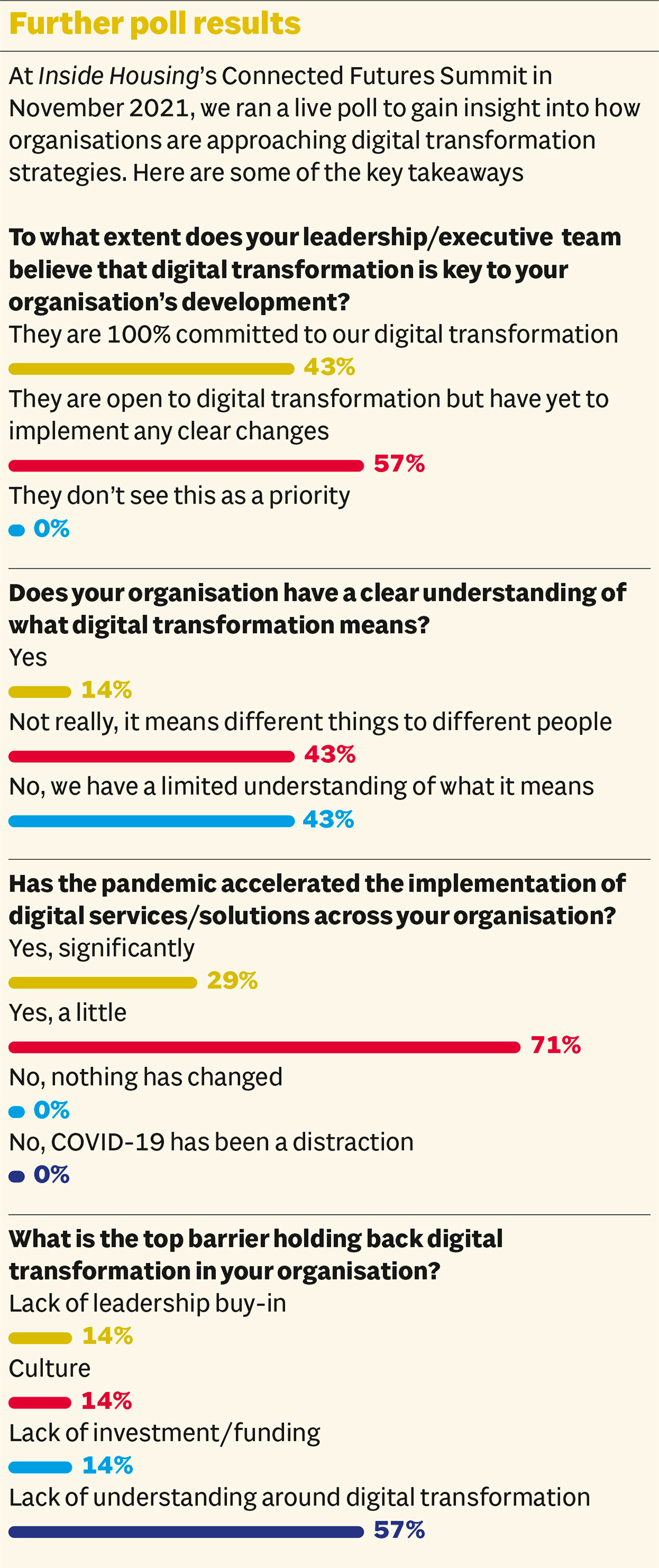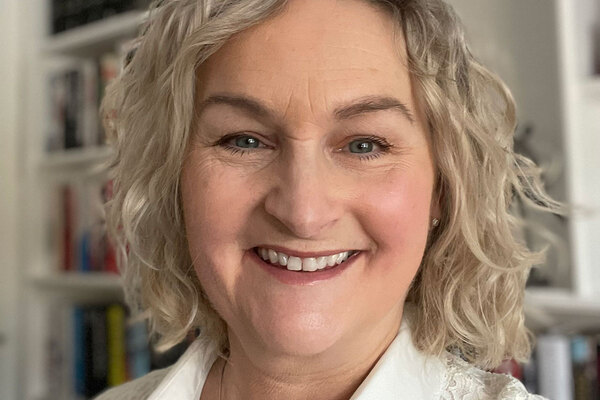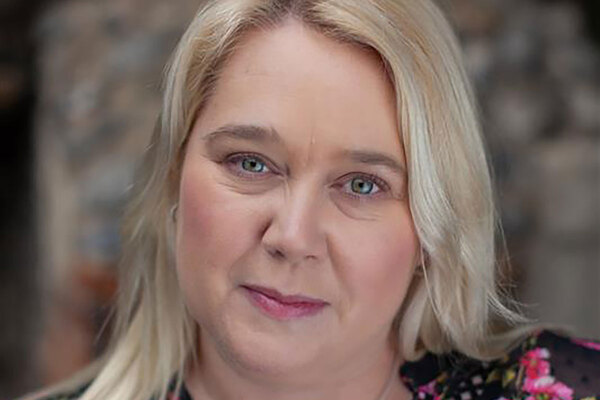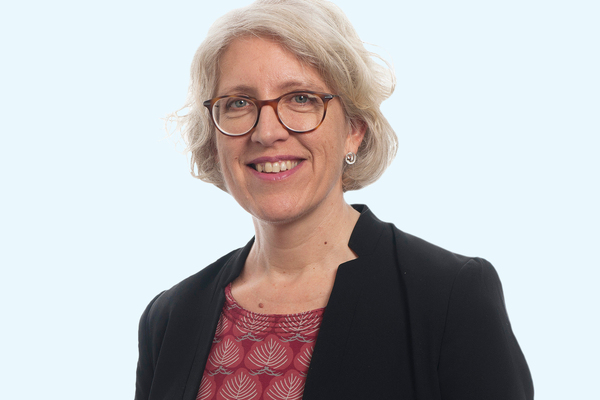Are landlords embracing the drive towards a digital future?
An Inside Housing survey, in association with Capita, reveals how landlords are setting up strategies – and why some aren’t doing so yet
In association with:
![]()
For many social landlords, digital services and solutions will play an increased role in tackling the challenges they face in the coming months and years. From boosting resident engagement and customer satisfaction, to delivering building safety legislative requirements and improving asset management, digital systems can provide far-reaching benefits. But while landlords seem intent on moving towards a digital future, how close is this to being a reality?
Capita supported a series of surveys by Inside Housing, which gets under the skin of the drive towards a digital future, including where organisations are focusing their efforts and what barriers stand in the way. The research sought views via a survey, in addition to separate polls during the Connected Futures Summit in November and across social media.
Accelerated by pandemic
A total of 120 organisations responded to the survey, of which 81% were housing associations, 7% were ALMOs and 3% were local authorities. The survey showed that while the digital agenda was seen as a top priority for 84% of landlords, less than half of respondents said they actually had a digital strategy in place.
Of those who said they had a strategy in place, nearly half had only implemented it in the past 18 months, with a further 62% saying the pandemic had accelerated their plans. A much smaller 5% said they had implemented a strategy more than five years ago.
A further 57% of people polled at the Connected Futures Summit – which was held last November and brought together leaders to explore how organisations can improve working environments in line with tenants’ needs – said they had developed a strategy but had yet to implement it, while a third said they were developing plans or were intending to do so, which suggests many organisations are still at the beginning of their journey.
Newydd Housing Association has been following a digital ‘roadmap’ since 2017. Elizabeth Lendering, its finance and resource director, says: “In about 2017, we had a brainstorm about all the things we were doing, all the things that were annoying us, and we basically had a list of things we wanted to get together. We broke the road map down into four areas.”
Those four areas were: information and data, which looked at the group’s core systems; efficiencies, which focused on cleansing the data it held and “getting rid of spreadsheets” to make information more accessible; communication and technology, which included getting tenants to use a self-service portal; and the creation of a digital inclusion strategy for tenants.
Much of the focus for other organisations has been on getting the right systems in place to facilitate any digital improvements, particularly when it comes to housing management. As an IT specialist from one association explains: “A lot of the tools and systems we’ve had in place are no longer fit for purpose. Historically, our approach has been quite piecemeal – so adding on, extending, or modifying our systems. Now, we want to put back down the foundations in a modern way. So, we are looking at changing how we do our mastered asset data, our asset information systems, our housing management solutions and other areas around that.”
The specialist says their organisation is opting to buy an “off-the-shelf system” rather than building its own because it was a quicker and cheaper route.
More customised approaches can be seen by the likes of BPHA. The organisation is developing its own system via Microsoft Dynamics to create what it calls “the single vision”, which will pull together tenant and property data to give a fully rounded tenant profile.
This will essentially be one major system, which is then supported by specialist subsidiary systems. The main system will be able to draw on this supported information when needed, explains Adrian Moore, IT director at BPHA. He says: “We are using Dynamics to ‘surface’ information. For example, our compliance system, which manages our gas compliance, fire safety and asbestos, is a different system but we’re surfacing that information into Dynamics so the person dealing with that customer – who could be in a contact centre or somebody in the field – can see that whole picture or ‘one vision’ of the entire customer relationship and the entire property relationship and how they interact.”
Mr Moore says BPHA will also give its tenants access to the same data through a digital portal. “This could be as simple as if they have a webchat with our contact centre. The transcript of that will end up in the single portal, in the single view, so everyone can see the last conversation they had with the customer, which means we can behave in a joined-up way,” he says.
Wales-based Pobl Group has also been overhauling its “disparate” systems, according to Nick Batt, its director of customer experience. He says: “Because of our scale and the fact that we’ve grown a lot from mergers and acquisitions, we’ve changed the name above the door but behind the scenes there are many disparate systems, [meaning] it’s really hard to get an accurate picture of the customer.” He adds: “Our biggest piece of work both in terms of time, effort and, significantly, cost [has been focused on answering]: what’s our central data platform that we can then build everything from?
“From there we can use that to power customer portals, so self-serve channels for customers. It will be linked into our website to increase what customers can do from a self-service perspective. Then when a customer contacts us via online or phone, that data platform will be the single source of truth, where they can access information about the customer or property to make sure they give them the best service.”
Our research showed, however, that while some organisations are working towards a single or more consolidated system, 40% of those polled on social media said they still had multiple systems to manage their stock, while 23% admitted they did this manually.
Explaining the reason for this, Glenn Allan, head of product for housing at Capita, says: “Quite a lot of this takes place because the responsibility of purchasing or acquiring the system has previously fallen with individual business areas within an organisation. So, the asset management team will go out and procure the asset management system rather than having a centralised strategy. What I’ve found is that those who have a centralised strategy tend to have fewer systems.”
Understanding tenants
Elsewhere, the survey shed light on the extent to which organisations are using data to better understand their tenants, with nearly two-thirds saying the information they collect on their tenants was limited.
A number of respondents anecdotally said they intended to increase the level of data they held on their tenants. One survey respondent said they had plans to “cleanse and review” this tenant information, which will then identify gaps and enable them to better tailor their communication and services.
A further 35% of survey respondents said they were not currently factoring data held on tenants by wider social infrastructure networks (such as community service, police and educational groups) into their digital plans, with one respondent flagging GDPR as a barrier to “embracing digital access with partnership agencies”.
Mr Allan adds: “You can use this data for fair processing reasons as long as you can justify it, so as long as you’re providing a service for someone who’s in crisis, then that’s valid.”
Beyond systems and data, additional initiatives are being introduced across social housing providers.
Ian Clark, executive director of business improvement at Together Housing, says that his organisation is taking a “decentralised approach” to digital innovation, where staff are encouraged to think of ways to improve their services. The group’s business improvement team then supports the roll-out of these innovations. He says: “We want the people who provide services to be the innovators responding to customer needs. They know what’s working and what needs to get better. [The business improvement team] can help guide them using data analysis, give them the tools to do it and advise appropriately.”
Challenges and barriers cited in the survey to delivering digital strategies and solutions were slightly weighted towards a lack of resident demand/buy-in (23%), a lack of skills/resource (20%) and a lack of understanding around digital transformation (17%).
In numbers
62%
Respondents who said pandemic had accelerated their digital strategy
5%
Proportion who implemented a digital strategy more than five years ago
40%
Percentage who still have multiple systems to manage stock
23%
Amount who still manage stock manually
57%
Respondents to one poll who cited lack of understanding around digital transformation as the top barrier
Stakeholder buy-in
One survey respondent said for their organisation, the biggest challenge was getting the right stakeholder buy-in within the business. They said: “Big digital transformation takes a long time so it’s a challenge to get a business to stick to its plans because it will be weighing up immediate pressures with the future.”
Mr Moore says one challenge BPHA has overcome throughout the development of its system was “matching the speed of technical delivery and the speed of change adoption” within the business. He says: “In the early days when we asked the business, ‘where do we go forward from here?’, we [the IT team] were leading them [the business] much more than we are doing now. Now the business is thought-leading the technologists. It’s become a well-oiled symbiotic machine.”
A lack of understanding around digital transformation being a top barrier increased to 57% among those polled during one session at the Connected Futures Summit.
During a separate session, 100% of people said culture was a top barrier. The same poll also showed mixed views at the top of organisations, with 57% saying their leadership was open to the digital agenda but had yet to implement clear changes.
For Jason Wroe, chief executive at Newydd Housing Association, getting people on board with the digital journey has been tough. He says: “Before the pandemic [the focus on digital] was all about cost and value for money [and] money was enough to get some people interested, but it was a real hard nut to crack. The only reason the nut cracked was because of the pandemic and everybody realised we were going to have to have digital services because if half of our staff were down with COVID-19, we needed a system that could cope and allow the remaining staff to still function a service.”
His organisation is developing a digital strategy. He says it has also been important to involve tenants. “There’s a conversation that needs to be had with tenants as to what they actually want and what level of digital service they need.”
Another respondent summed up: “Not all residents have access or can afford broadband and/or digital devices. English may not be their first language, or they may not feel confident using the phone or a device. Customer choice is critically important.”











